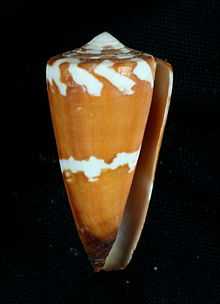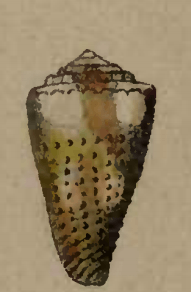Conus litoglyphus
| Conus litoglyphus | |
|---|---|
 | |
| Shell of Conus litoglyphus Hwass in Bruguière, 1792, measuring 44.3 mm in height, collected at low tide in coral sand off Zanzibar, in Africa. | |
| Scientific classification | |
| Kingdom: | Animalia |
| Phylum: | Mollusca |
| Class: | Gastropoda |
| (unranked): | clade Caenogastropoda clade Hypsogastropoda clade Neogastropoda |
| Superfamily: | Conoidea |
| Family: | Conidae |
| Genus: | Conus |
| Species: | C. litoglyphus |
| Binomial name | |
| Conus litoglyphus "Meuschen, F.C." Hwass, C.H. in Bruguière, J.G., 1792 | |
| Synonyms[1] | |
 Drawing of Conus litoglyphus | |
Conus litoglyphus, common name the lithograph cone, is a species of predatory sea snail, a marine gastropod mollusk, more popularly known as a cone snail, cone shell or cone. [1]
Like all species within the genus Conus, these snails are predatory and venomous. They are capable of "stinging" humans, therefore live ones should be handled carefully or not at all.
Shell description
The size of an adult shell varies between 35 mm and 75 mm. The shell is small with a low spire. It is dark brown in color with cream banding around the shoulders and across the body whorl. The narrow aperture is white with a brown coloration at the anterior end.
Distribution
This is an Indo-Pacific species, found along the Red Sea and in the Indian Ocean along Aldabra, Chagos, the Mascarene Basin and Mauritius.
Gallery
-

Conus litoglyphus Hwass in Bruguière, J.G., 1792
-

Conus litoglyphus Hwass in Bruguière, J.G., 1792
-

Conus litoglyphus Hwass in Bruguière, J.G., 1792
-

Conus litoglyphus Hwass in Bruguière, J.G., 1792
External links
- Gastropods.com : Conus litoglyphus; accessed: 6 September 2011
- Conus litoglyphus Picture - Picture of shells of this species
- Catalogue of recent and fossil Conus - Picture and account of this species
- Cone Shells - Knights of the Sea
References
- ↑ 1.0 1.1 Bouchet, P. (2011). Conus litoglyphus Hwass in Bruguière, 1792. Accessed through: World Register of Marine Species at http://www.marinespecies.org/aphia.php?p=taxdetails&id=215430 on 2011-09-05
- Drivas, J. & M. Jay (1988). Coquillages de La Réunion et de l'île Maurice.
- Richmond, M. (Ed.) (1997). A guide to the seashores of Eastern Africa and the Western Indian Ocean islands. Sida/Department for Research Cooperation, SAREC: Stockholm, Sweden. ISBN 91-630-4594-X. 448 pp.
- Filmer R.M. (2001). A Catalogue of Nomenclature and Taxonomy in the Living Conidae 1758 - 1998. Backhuys Publishers, Leiden. 388pp.
- Tucker J.K. (2009). Recent cone species database. September 4th 2009 Edition.
- Tucker J.K. & Tenorio M.J. (2009) Systematic classification of Recent and fossil conoidean gastropods. Hackenheim: Conchbooks. 296 pp.